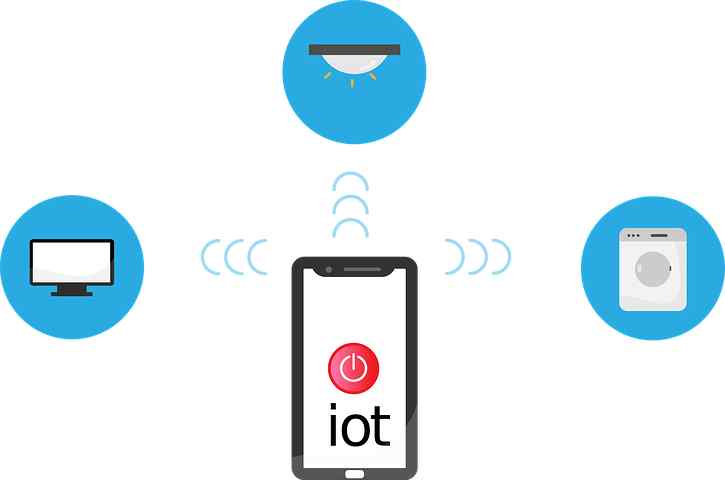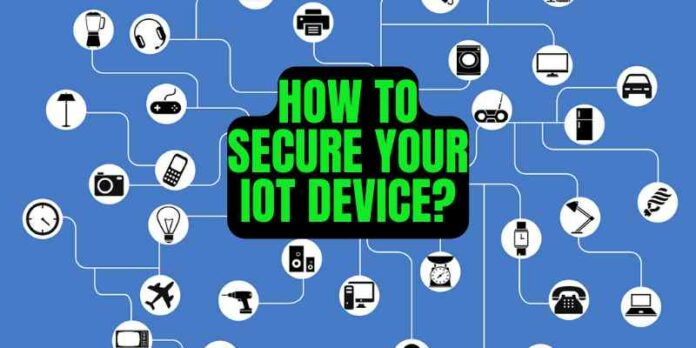IoT devices make your life easier and more efficient. IoT lets you control your room temperature, security door, and home appliances. But, in the online world, there are a lot of hackers and attackers who commit data breaches. In this article, we will discuss how to secure your IoT device.
What is IoT?
 The Internet of Things (IoT) is a network of physical objects embedded with software, sensors, and other relevant technology to exchange data among different devices. It allows us to add objects like vehicles, lights, air conditioners, refrigerators, and other electronic systems. It has four types of a network cellular, local and personal area network, low power vast area network, and mesh network. Now, the application of IoT is everywhere.
The Internet of Things (IoT) is a network of physical objects embedded with software, sensors, and other relevant technology to exchange data among different devices. It allows us to add objects like vehicles, lights, air conditioners, refrigerators, and other electronic systems. It has four types of a network cellular, local and personal area network, low power vast area network, and mesh network. Now, the application of IoT is everywhere.
How Does IoT work?
 The Internet of things is interrelated connected devices that can transfer data without human intervention. Four distinct components are connected to work the system. The components are sensor devices, network systems, data processing, and user interface.
The Internet of things is interrelated connected devices that can transfer data without human intervention. Four distinct components are connected to work the system. The components are sensor devices, network systems, data processing, and user interface.
Through the device sensor, it collects data over the network. The data is sent to the cloud, which is integrated with the software. The cloud software analyses the data and sends it to the user through App or the web.
What are the Threats
The internet world is full of risk. Hackers and others with ill intentions can access your network if you are not cautious. The probable threats are:
- Lack of built-in security
- Malware attacks
- Data loss
- Physical security
- IoT misconfiguration
How to secure your IoT device?
 The Internet of things has become the core of daily comfort. The expansion of the network causes a complex scenario. It has become a security problem. However, the solutions are readily available. Here are the 20 best solutions to protect your IoT devices and data.
The Internet of things has become the core of daily comfort. The expansion of the network causes a complex scenario. It has become a security problem. However, the solutions are readily available. Here are the 20 best solutions to protect your IoT devices and data.
1. Setup the router correctly
A router is a doorway to your IoT system. Some people use IoT routers to make the system more secure. Before deploying the IoT router, change the default name and password. Your new password should be unique and challenging. Finally, use a high level of encryption.
2. Use a super strong password
All the system is connected with a password. The IoT system could be more exceptional. Moreover, your IoT system requires a login credential with a strong password. There is a specific guideline for making a strong password. Besides, numeric and alphanumeric words use special characters to make it difficult. A small effort can protect you from significant danger.
3. Avoid using public WiFi
Using a public network from restaurants or open places will be risky to access your financial system and IoT network. The virtual private network (VPN) may be responsible for securing your WiFi network. The VPN will give you a private encrypted gateway to the Internet to stop inception in your network.
4. Start using the guest network
Many times your guests may visit your house. Never allow them to use your primary network. Always allow them to use your guest network. You can also provide a guest network for your IoT devices. That means the hacker can access your guest network but will get access to your IoT network.
5. Secure your IoT device by Skipping all default
The default system is known to anyone. So, you can ensure your IoT system security by changing all the default settings. Change all of your settings every 90 days. There is a scope to customize all of your settings. Disable all of your unnecessary modules. Enable it once it is needed.
6. Encrypt your connection when online
Your online connection needs to be secure always. There are a lot of ways to secure your online connection. Most of the secured process is using VPN. It is a ‘kill-switch’ feature to protect your data. However, your IoT system can be protected using any good VPN.
7. Software up-to-date
Software developers frequently receive bugs from all over the world. They compile all the bugs and make a patch to solve all the bug issues. So, you must update your system or install updated patches to keep your system running. Sometimes, your router’s firmware may not update automatically. In that case, you have to update it manually.
8. Multi-factor authentication
Now Google Mail to the banking system uses Multi-factor authentication. It can be a combination of your biometrics and password or face authentication with the password. Sometimes it can be an email/SMS code with a password. However, OTP is the best to use. It can make your IoT system more secure and less vulnerable.
9. Utilise network segmentation
Network segmentation means splitting your internal network into multiple parts. They should be independent and isolated from each other. With the help of protection and detection network software, you can ensure a more secure network. The network segmentation minimizes your damage and limits your attack area.
10. Secure your IoT device by monitoring the system
IoT works with the critical operation and sensitive data. It is a live operation that continuously follows your data. So, there should be a monitoring system. It can track your IoT devices and check the system’s health. When unusual data is followed, it can stop any suspected network. Instantly the concerned person can come to know the situation.
11. Disable the features you don’t use
IoT is a system that allows you to work anywhere in the world. But, when you are at home, there is no requirement to use it outside your premises. The hackers can quickly get access and take control of your system.
12. Employ the next-generation firewall
A next-generation firewall is an integrated network platform that combines traditional firewalls and other modern security functionalities. A traditional firewall is known as a built-in firewall. It can not ensure the security of prevention systems (IPS), virtual private networks (VPN), malware protection, content filtering, QoS management, and SSL/SSH interception. Next-generation firewalls can protect you from all those problems. But it is a costly investment.
13. Disconnect the IoT System when you don’t need
All the devices may have an IoT connection. But it only requires some time. Most of the time, you stay at your home. So, connecting the refrigerator and washing machine to the Internet is not required. So, disconnect the IoT system when you do not need it.
14. Avoid universal plug and play
Universal plug-and-play (UPnP) can make your system vulnerable. It can connect your printer, router, PC, and other devices to hackers. The principle of UPnP is to connect any device without any setup. It saves time and effort. But it’s a significant threat to the system. So, it will be best to turn off UPnP completely.
15. Secure your IoT device with IoT security analytics
We usually keep IoT devices in disparate environments. But, there is a critical requirement to monitor all of those. IoT security analytics can solve the issue. It can predict unwanted behavior and behavioral changes. In this way, it can mitigate the problems in advance.
16. Public critical infrastructure
PKIs or Public key infrastructure is a set of protocols to follow a registration process with a certification process. The number of hacking and data breach cases is increasing day by day. So, these PKIs help register different devices and instantly identify unidentified users.
17. Secure cloud platform
The data of the IoT system is stored on a cloud platform. The volume of data is enormous. As a result, there is a question of security. There should be an authentication system. The login tracker will give more security. After a few failed login attempts, the owner should be informed instantly.
18. Protect sensitive information
Personally identifiable information (PII) is very sensitive. So, as an IoT user, you have to stop such leakage from stopping transmitting sensitive information. You can restrict all external devices other than your required devices. Develop such a network where unauthorized clients can not discover your network.
19. Minimise device bandwidth
IoT-borne distributed denial of service (DDoS) attacks are a concern. Any parallel system may be deployed to steal your data when you have an abundant network bandwidth. Allot only the required bandwidth to ensure the security of IoT devices.
20. Improve failure design
This system is helpful for door lock systems, patient monitoring systems, and environmental monitoring alarms. Any unwanted incident may happen when the connection is lost or any technical failure. The failover design ensures user safety and security. The system should have a parallel mechanism to ensure redundancy.
Final Thought
Securing IoT devices is relatively easy. But it takes a lot of effort. Using VPN will be the best solution. However, Cyber Ghost VPN is our recommendation. Besides using the VPN, you can follow the different options line IoT router, avoiding unnecessary exposure, and PKIs can secure your IoT device.





